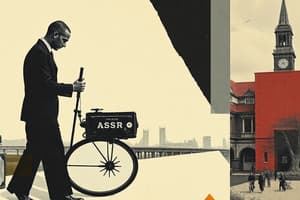Podcast
Questions and Answers
What is the Marginal Product of Labor (MPL) most directly related to in hiring decisions?
What is the Marginal Product of Labor (MPL) most directly related to in hiring decisions?
- The average output produced by all workers.
- The contribution of the next worker to total revenue. (correct)
- The total revenue from selling all output.
- The firm's overall production capabilities.
When should an employer choose not to hire an additional worker based on economic principles?
When should an employer choose not to hire an additional worker based on economic principles?
- When the wage rate is less than the Marginal Revenue Product (MRP).
- When the Marginal Product of Labor is increasing.
- When the employer is indifferent to hiring the worker.
- When the wage rate is greater than the Marginal Revenue Product (MRP). (correct)
Which factor does NOT typically influence the demand for labor in a firm?
Which factor does NOT typically influence the demand for labor in a firm?
- Changes in consumer preferences.
- The price elasticity of the product.
- The level of human capital among workers.
- An increase in wage rates. (correct)
What does the opportunity cost of labor refer to in a business context?
What does the opportunity cost of labor refer to in a business context?
How does human capital influence labor demand in a given market?
How does human capital influence labor demand in a given market?
What is economic rent?
What is economic rent?
Which factor does NOT typically influence an individual's decision to migrate?
Which factor does NOT typically influence an individual's decision to migrate?
What is the primary effect of immigration on the supply of labor?
What is the primary effect of immigration on the supply of labor?
What typically represents a change in quantity supplied in the labor market?
What typically represents a change in quantity supplied in the labor market?
What does a backwards-bending individual labor supply curve indicate?
What does a backwards-bending individual labor supply curve indicate?
Which statement best describes human capital?
Which statement best describes human capital?
Which of the following is a potential consequence of emigration on the labor market?
Which of the following is a potential consequence of emigration on the labor market?
What is one major factor in determining the elasticity of labor supply?
What is one major factor in determining the elasticity of labor supply?
What is the concept of opportunity cost in the context of labor supply?
What is the concept of opportunity cost in the context of labor supply?
What is meant by human capital in the context of the labour market?
What is meant by human capital in the context of the labour market?
What primarily influences an individual's decision to participate in the labour force?
What primarily influences an individual's decision to participate in the labour force?
How is the labour supply curve for an occupation generally derived?
How is the labour supply curve for an occupation generally derived?
What does the term 'opportunity cost' refer to in the context of work and leisure?
What does the term 'opportunity cost' refer to in the context of work and leisure?
What is a characteristic of leisure in relation to income?
What is a characteristic of leisure in relation to income?
Under what conditions might an individual's labour supply curve bend backwards?
Under what conditions might an individual's labour supply curve bend backwards?
Which of the following best describes the substitution effect in the context of labour supply decisions?
Which of the following best describes the substitution effect in the context of labour supply decisions?
Flashcards
Human Capital
Human Capital
Human resources, like skills and education, that contribute to the economy.
Work/Leisure Tradeoff
Work/Leisure Tradeoff
People can either work for pay or enjoy leisure time.
Opportunity Cost of Work
Opportunity Cost of Work
The leisure time given up to work.
Normal Good (Leisure)
Normal Good (Leisure)
Signup and view all the flashcards
Marginal Tax Rate
Marginal Tax Rate
Signup and view all the flashcards
Reservation Wage
Reservation Wage
Signup and view all the flashcards
Economic Rent
Economic Rent
Signup and view all the flashcards
Marginal Revenue Product (MRP)
Marginal Revenue Product (MRP)
Signup and view all the flashcards
Labour Demand Curve
Labour Demand Curve
Signup and view all the flashcards
Employer's Decision Rule for Hiring
Employer's Decision Rule for Hiring
Signup and view all the flashcards
Marginal Product of Labour (MPL)
Marginal Product of Labour (MPL)
Signup and view all the flashcards
Demand for Labour (in Perfect Competition)
Demand for Labour (in Perfect Competition)
Signup and view all the flashcards
Reservation Wage Rate
Reservation Wage Rate
Signup and view all the flashcards
Immigration
Immigration
Signup and view all the flashcards
Emigration
Emigration
Signup and view all the flashcards
Labour Supply Curve
Labour Supply Curve
Signup and view all the flashcards
Brain Drain
Brain Drain
Signup and view all the flashcards
Factors Influencing Migration
Factors Influencing Migration
Signup and view all the flashcards
Individual's Labour Supply Curve
Individual's Labour Supply Curve
Signup and view all the flashcards
Market Supply Curve
Market Supply Curve
Signup and view all the flashcards
Change in Supply vs. Change in Quantity Supplied
Change in Supply vs. Change in Quantity Supplied
Signup and view all the flashcards
Study Notes
Chapter 8: Labour Market Decisions of Households: The Supply of Labour
- The chapter discusses the supply of labour by households.
- Key concepts include human capital, normal goods, income effect, substitution effect, reservation wage rate, marginal tax rate, economic rent, and demogrant.
- Factors influencing an individual's decision to participate in the labor force and supply labor are explored.
- The derivation of individual and market supply curves for labor in an occupation is described.
- The difference between a change in supply and a change in quantity supplied is explained.
- Conditions under which an individual's labor supply curve bends backward are identified.
- Wage rate elasticity of labor supply and its application in various occupations are discussed.
- Analyzing work disincentives associated with non-employment income is part of the discussion.
- The impacts of immigration and emigration on labor supply curves for different occupations and worker migration patterns are examined.
- Defining human resources by skills, education etc. is described as human capital
- Labor supply is considered human capital.
The Work/Leisure Tradeoff
- Individuals can either work or enjoy leisure.
- Opportunity cost of work is leisure.
- Leisure is a normal good—more desired with increased income.
Leisure Activities
- Leisure covers non-market work (e.g., household chores), consumption time (e.g., enjoying goods and services purchased), and idleness (e.g., rest and relaxation).
Demand for Leisure
- The demand for leisure is influenced by income and wealth.
- A positive income effect correlates with more leisure time.
- Income effect (supply): The change in hours caused by a change in income: Negative effect on supply
- Substitution Effect: As the wage rate increases the price of leisure increases, so leisure hours decrease. This results in a positive effect on work.
Factors Influencing the Decision to Work
- Age, life cycle issues
- Reservation wage rate (lowest acceptable wage)
- Mandatory retirement
- Fertility and family size
- Investment in education
- Non-employment income, e.g., inheritance, demogrants, benefits, subsidies
Types of Non-Employment Income
- Inheritance
- Demogrant
- Welfare benefits
- Employment insurance
- Subsidized daycare
Individual Labor Supply Curve
- A graph showing the relationship between the wage rate and the number of work hours.
- At low wages, individuals are not willing to work many hours.
- As wages increase, the opportunity cost of not working increases.
Backward-Bending Supply Curve for Labor
- At a certain point, the individual might choose to purchase more leisure.
- The slope of the supply curve becomes negative at this point.
- The substitution effect dominates at low wage rates but the income effect takes over at high wage rates .
What is the Price of Leisure?
- "Price of leisure" is the wage rate for the time not worked (the opportunity cost).
Wage Rate Elasticity of Labour Supply
- The coefficient describes the percentage change in labor supply in response to a percentage change in the wage rate.
Impact of Tax on the Decision to Work
- Marginal tax rates affect work decisions.
- Higher marginal tax rates often result in a disincentive to work more hours.
Market Supply Curve for Labor
- Sum of individual labor supply curves for a particular occupation.
- Generally an upward-sloping curve.
Changes in Supply
- Increased supply of labor due to: more trained workers, reduced barriers to entry, and increased immigration.
Changes in the Quantity Supplied of Labor
- Movements along the supply curve represent changes in the quantity supplied, not the supply itself.
- Changes in wages cause movements along the supply curve.
The Impact of Migration on the Labor Supply Curve
- Immigration increases labor supply.
- Emigration decreases labor supply; can cause a "brain drain".
Economic Rent
- Wage received above the reservation wage.
Chapter 9: Labour Market Decisions of Firms (Micro) Demand for Labour
- Focuses on labor demand from the firm's perspective.
- Important terms : derived demand, law of diminishing returns, short-run and long-run distinction, marginal productivity of labor, marginal revenue product, scale effect, substitution effect ,quasi-fixed labour costs.
- Explains how the demand curve for a specific occupation shifts.
- Discusses factors that influence wage elasticity of demand and productivity in Canada.
- Explores types of quasi-fixed labor costs and their influence on hiring decisions.
- Demand for labour is derived
- Demand is influenced by productivity (education and experience).
- Demand is a function of the market price perception of the service
Demand Curve for Labour
-
Short-run: at least one factor cannot change
-
Law of Diminishing returns (LDR): a point is reached in the short run where there is less contribution to total output
-
Marginal Product of Labor (MPL): the contribution of the next worker to total output
The Decision to Hire
-Compare MRP(Extra revenue) to MC(extra costs)
- Hire if MRP is greater than the wage rate.
Shifts in the Demand Curve
- Scale effect: change in number of employees hired because of changes in the amount of product sold -Increased productivity increases the demand for labour. Demand for labour can increase because of an increase in demand for final goods and services. Price of substitute goods. Price of complementary goods.
The Market Demand for Labour
- overall demand can change because of changes in demand for goods and services and changes in the prices of substitute and complementary goods
Using Wage Elasticity of Labour Demand
Wage Elasticity of Labour Demand
- Inelastic: percentage change in quantity demanded by firms is less than the percentage change in wages
- Elastic: percentage change in quantity demanded by firms is greater than the percentage change in wages
Wage Elasticity of Labour Demand
- Depends on: percentage of labor costs in total costs, number of substitutes for labor, price elasticity of product/service
Cross Elasticity of Demand
- Changes in wages in one occupation can affect demand in another.
- Substitution vs Complementary effect.
- Coefficient defined as percentage change in quantity demanded for occupation A ÷ percentage change in wage rate for occupation B
Labour Productivity
- Output per worker.
- Productivity increase with more effective workers.
Productivity Growth - Macro Influences
- Structure of the economy (manufacturing vs. services).
- Economic conditions (recession vs. expansion).
- Government policies (fiscal policy).
Productivity Growth - Micro Influences
- Scale of business operations (large firms).
- Management techniques affect staff motivation, use of better tools and equipment.
Productivity Growth - Micro/Macro
- Combination of micro and macro factors.
- Quality and quantity of capital influence employee productivity.
- Labor force characteristics (age, health, education, skill training) impact productivity.
Quasi-Fixed Labour Costs
- Costs of hiring employees not related to work hours.
- Examples include hiring costs, training costs, and opportunity costs (lost production).
Studying That Suits You
Use AI to generate personalized quizzes and flashcards to suit your learning preferences.




